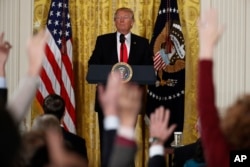Donald Trump's unique, Twitter-driven presidency has re-energized and personalized a national debate on the media as old as the First Amendment.
Trump, backed by some pundits and commentators on the right, has described some leading news outlets as "the enemy of the people," intent on destroying his presidency.
He asked Wednesday on Twitter when it is appropriate to challenge the broadcast licenses of some outlets he accuses of spreading "fake news."
Defenders of journalism counter there's nothing new in a president chafing at reporting of his administration's foibles, as every one of his modern-day predecessors has done.
The difference is Trump's use of social media to amplify his criticisms, and the determination of some of America's journalistic powerhouses to increase manpower and reporting they say is aimed at holding the administration accountable.
In a steady drumbeat of Twitter posts, Trump has cast himself as the victim.
"Wow, so many Fake News stories today. No matter what I do or say, they will not write or speak truth. The Fake News Media is out of control!" he tweeted.
Studies show that coverage of Trump has tilted heavily to the negative. A content analysis done by the nonprofit Pew Research Center showed that reporting about the first months of the Trump presidency was 62 percent negative and five percent positive.
By contrast, the early 2009 coverage of President Barack Obama's presidency was 42 percent positive and 20 percent negative, according to Pew. Presidents Bill Clinton and George W. Bush also had higher negative than positive coverage, but nothing like Trump's.
Trump critics see nothing exceptional in those figures given the volume of missteps and misstatements coming from the Oval Office, but Trump and his supporters interpret them as evidence of malign intent.
In post after post on Twitter, the president has pointed the finger directly at some of America's most influential media and platforms, accusing them of misrepresenting facts and telling outright lies, and suggesting there is a concerted campaign to damage his presidency.
'Contempt for Trump'
Angered by an NBC News story last week that quoted Secretary of State Rex Tillerson as having called him a "moron," Trump demanded an apology and called for a congressional investigation.
While the prospect of a Senate probe seems remote, the president's complaints have reinvigorated some media critics.
"The national media have a dramatic contempt for Trump," said Tim Graham, director of media analysis at the conservative Media Research Center. "They not only did not vote for him, they really feel he is a dangerous moron, which is why this [NBC] story resonates with them."
"The tenor of the discussion is, Trump has to deny he's a moron. That, to them, is a good day," Graham told VOA.
'False narratives'
Members of the journalistic community, however, say their coverage is about holding the administration accountable.
Former New York Times executive editor Jill Abramson, writing in the Columbia Journalism Review, said, "The quixotic nature of the new administration … and the false narratives that tumble out of the White House daily, cry out for this kind of accountability journalism."
At the same time, Abramson warned her former colleagues that some commentary, and the sheer volume of coverage, could be construed by critics as "gloating" or "overkill."
"This doesn't mean holding back stories, mincing words, or publishing bland journalism that equates both sides or makes false equivalencies," the former Times editor wrote. "It means not taking cheap shots, not publishing biased headlines ... and not overreaching."
Indira Lakshmanan, the Newmark Chair for Journalism Ethics at the Poynter Institute, argues Trump's attacks on the media are threatening legitimate concerns over "fake news," a term originally coined to describe hoax stories meant to disinform and influence, or simply earn advertising dollars on the internet.
"Trump has turned a genuine scourge that threatens an informed populace and our democracy on its head by deeming any critical reports on him that he doesn't like 'fake news' in an effort to undermine the credibility of Washington political reporting and mainstream, fact-based journalism in general," Lakshmanan said in a statement to VOA.
Ironically, the media may be the long-term beneficiary of Trump's ire. Newspapers such as the Times, which the president often refers to as "the failing New York Times," have shown significant increases in readership and revenue.
"Every time I hear him tweet about the 'failing @nytimes' or use the shopworn sobriquet 'fake news,' I also hear the ka-ching of the so-called 'Trump bump,' which has helped kick the Times' digital subscriptions above two million since the election, a revenue stream that is crucial to support its reporting staff at current levels," Abramson noted.





























